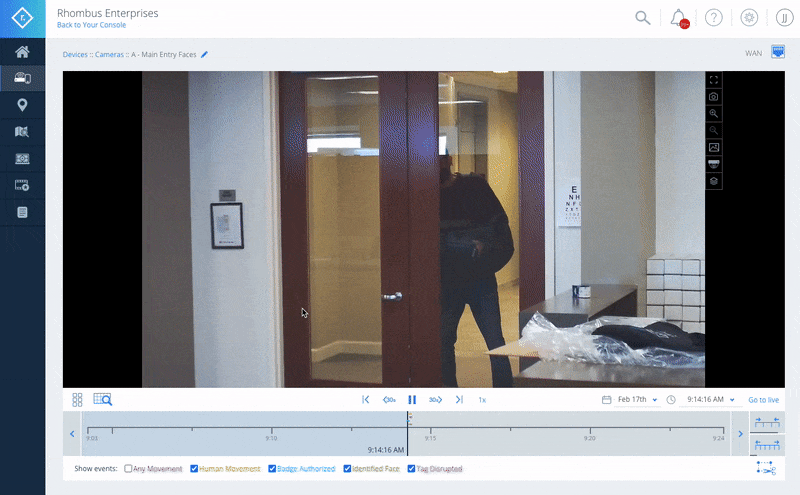
School Safety: Cloud vs On-Premise Video Security Myths Dispelled
February 18, 2021

When you’re evaluating video security for your school, the question inevitably comes up: which is better, a cloud or on-premise (DVR/NVR) system?
There are pros and cons to each type of solution and it’s important to perform due diligence on all potential vendors. However, there are several common misconceptions about cloud video security solutions that often arise and muddy the waters. In this post, we’ll discuss and debunk the biggest myths about cloud video security.
For an in-depth breakdown on how to choose a video security solution for your school, read: How to Choose the Right Video Surveillance System for Education.
1. The Myth of Security
MYTH: Cloud video security isn’t secure
TRUTH: Cloud video security solutions are just as secure as on-premise systems
There’s a common misconception that cloud systems aren’t secure when compared to on-premise systems. This information is incorrect and true system security varies from manufacturer to manufacturer. If your current on-premise system requires you to port-forward for remote access, poke holes in your firewall, or is leveraging outdated firmware – this can cause your surveillance system to become compromised.
Cloud systems like Rhombus follow the strictest cybersecurity protocols in the industry. SOC 2 Type 2 is the most comprehensive certification and requires the most rigorous adherence to the Trust Service Criteria: security, availability, processing integrity, confidentiality, and privacy. Many schools, businesses, and healthcare providers have chosen to upgrade to the cloud specifically for better reliability and security.

Some of the proactive cybersecurity practices that Rhombus include are:
- Automatic firmware updates: Updates happen automatically with zero effort on your part, so the system is always using the latest, most secure technology.
- Encryption that protects data at every level: Rhombus uses complete end-to-end encryption with all data encrypted at rest and in-transit. All video is LUKS AES-256 encrypted and all communication with the Rhombus Cloud uses TLS 1.2, AES-128 bit encryption.
- Regular 3rd party security audits: Rhombus regularly conducts 3rd security party audits and penetration testing to ensure organizations receive a secure solution that has been verified by cybersecurity experts.
For additional cloud security protocols, see an overview of Rhombus’ security practices.
2. The Myth of Expense
MYTH: Cloud systems are more expensive than on-premise
TRUTH: When you factor in total ownership costs and ROI, some cloud solutions are actually less expensive than traditional systems
The second most common myth is that in the long-term, cloud is more expensive than on-premise. Annual licensing fees are the main source of this concern. However, when you break down all the costs of system ownership, cloud consistently comes out as less expensive, even with annual licensing fees. (TIP: Watch out for “hidden costs” from both on-premise and cloud vendors. A common one is ongoing hidden fees if you run out of memory and storage.)

To understand total costs, let’s compare cloud vs on-premise systems:
-
Upfront costs: Cloud systems are less expensive upfront than on-premise systems. On-premise systems require more hardware than cloud solutions, and with more hardware comes more expense. Each location requires an NVR, a local viewing station, hard drives, and cameras—the cost adds up. To support 50 - 100 cameras and 30 days of video, an enterprise NVR device can cost anywhere from $30K - $50K.
With a cloud solution, the only devices you need to purchase and deploy are the cameras.
-
Management costs: Cloud systems are less expensive to maintain than on-premise systems. More hardware means more management and maintenance. Because on-premise systems require an NVR/DVR, hard drives, cameras, etc. – they typically involve more labor to ensure proper functionality. Additionally, on-premise systems are limited in terms of scalability. In the future, when you need to add more devices or users, this can drastically increase total hardware and labor costs.
With a cloud solution, you can save time and money on management by 1) eliminating excess hardware, 2) having a system that updates automatically, and 3) adding new users or devices without being limited or capped.

-
Operational costs: Cloud systems can improve operations and efficiency with modern technology. Staying with an older, traditional system that works “fine”, but not great, is expensive. You spend time and money on maintenance, labor, inefficiencies, and workarounds.
Organizations often see massive jumps in productivity after switching to Rhombus’ cloud solution. The most significant factors include:
- Smarter, faster search and incident investigation regularly saves schools hours of labor every day. For example, the staff at Birch Tree Academy used to manually rewind and fast forward through footage to find specific incidents. Rhombus’ automatic event tracking lets them find, save, and share footage in a matter of minutes.
- Remote access improves efficiency and reduces your reliance on onsite labor. This is especially true on a district-wide scale; see how Nemaha School District used cloud video security to improve efficiency across multiple campuses. With cloud, remote access comes standard, updates happen automatically, and troubleshooting can be done virtually from anywhere.
- Smarter, faster search and incident investigation regularly saves schools hours of labor every day. For example, the staff at Birch Tree Academy used to manually rewind and fast forward through footage to find specific incidents. Rhombus’ automatic event tracking lets them find, save, and share footage in a matter of minutes.

3. The Myth of Reliability
MYTH: Cloud is unreliable; if the internet goes down, the system stops working
TRUTH: Modern cloud video security solutions enable your system to work even during network outages
The third most common myth is that if your internet goes offline, a cloud system will stop working. This is untrue; Rhombus uses a hybrid solution with built-in redundancies and features that enable it to keep working even during an outage.
- No footage left behind: Through on-camera (“on the edge”) recording and processing, the system never stops working and no footage is ever lost, even during prolonged network outages. If the internet goes down, Rhombus continues to record and will automatically reconnect to the cloud once the connection is restored.
- Offline streaming in the mobile app: If your internet goes offline, you can now watch live and recorded video over the LAN with no internet access required. You can use the Rhombus iOS/Android mobile app to view live and recorded video so you always know what’s going on across your facilities.

Conclusion
Upgrading your school video security system is a big decision, and it’s important to have a clear understanding of your options. When you learn more about cloud video security solutions and see past the myths, the benefits are significant. Cloud is a reliable, smart, and cost-effective way to increase visibility, productivity and safety for schools.
Experience Rhombus for yourself—schedule a demo or a free trial.
For a high-level look at choosing a video security solution, check out: How to Choose the Right Video Surveillance System for Education.
See how the Rhombus + HALO integration solves student vaping: How to Prevent Student Vaping in Schools with Connected IoT Sensors

Try Rhombus for Free!
See why school districts, cities, and Fortune 500 companies use Rhombus.
Start Trial

